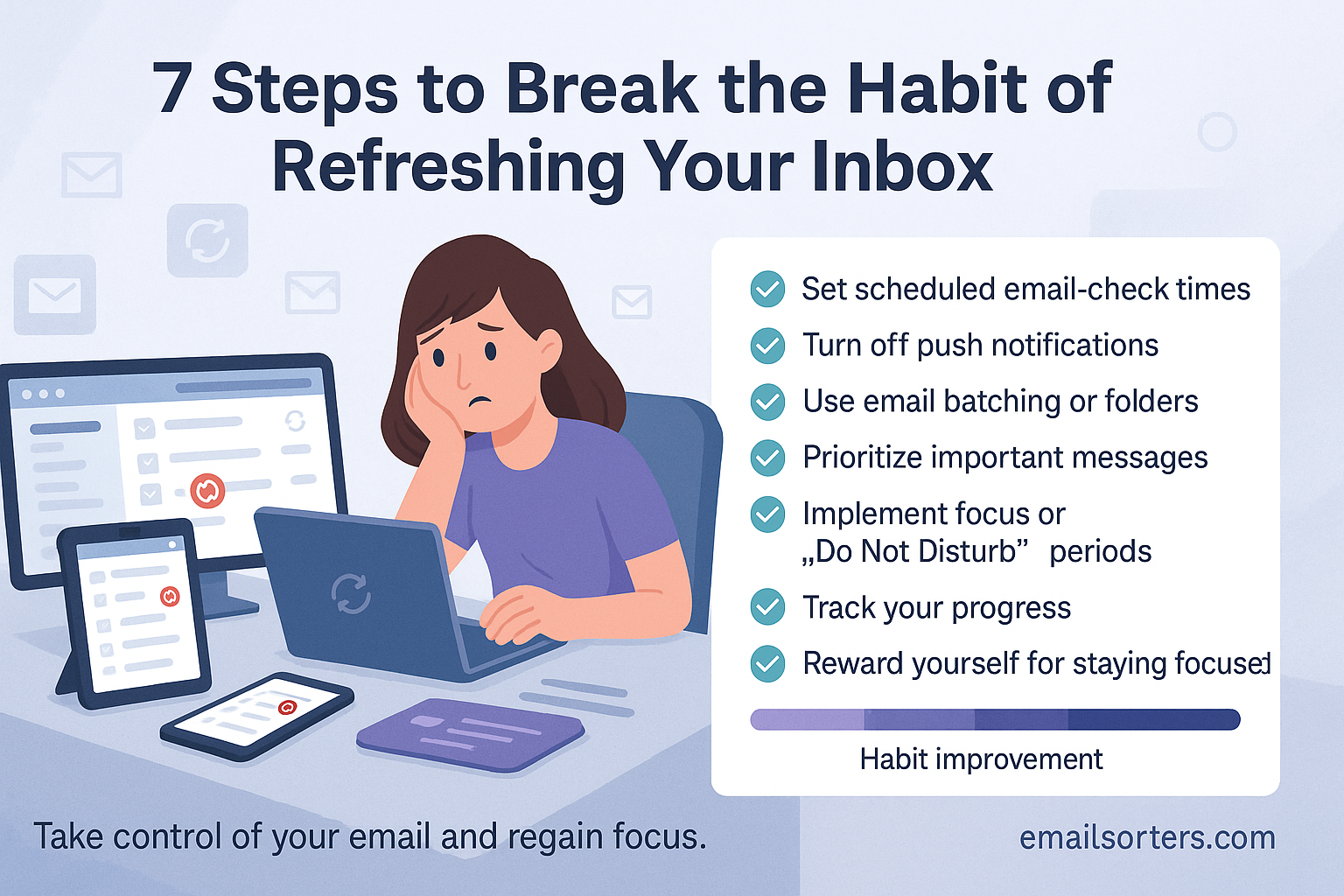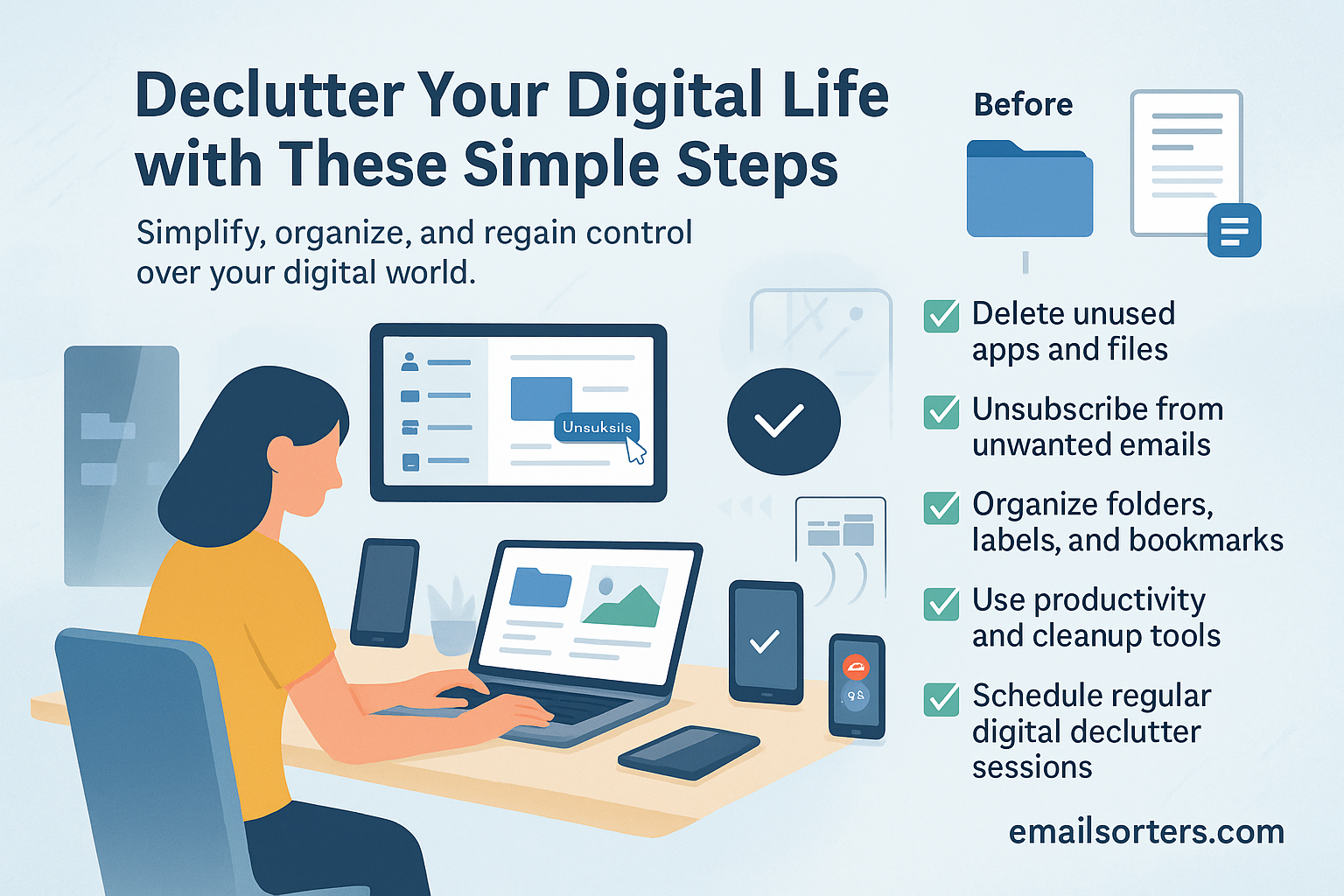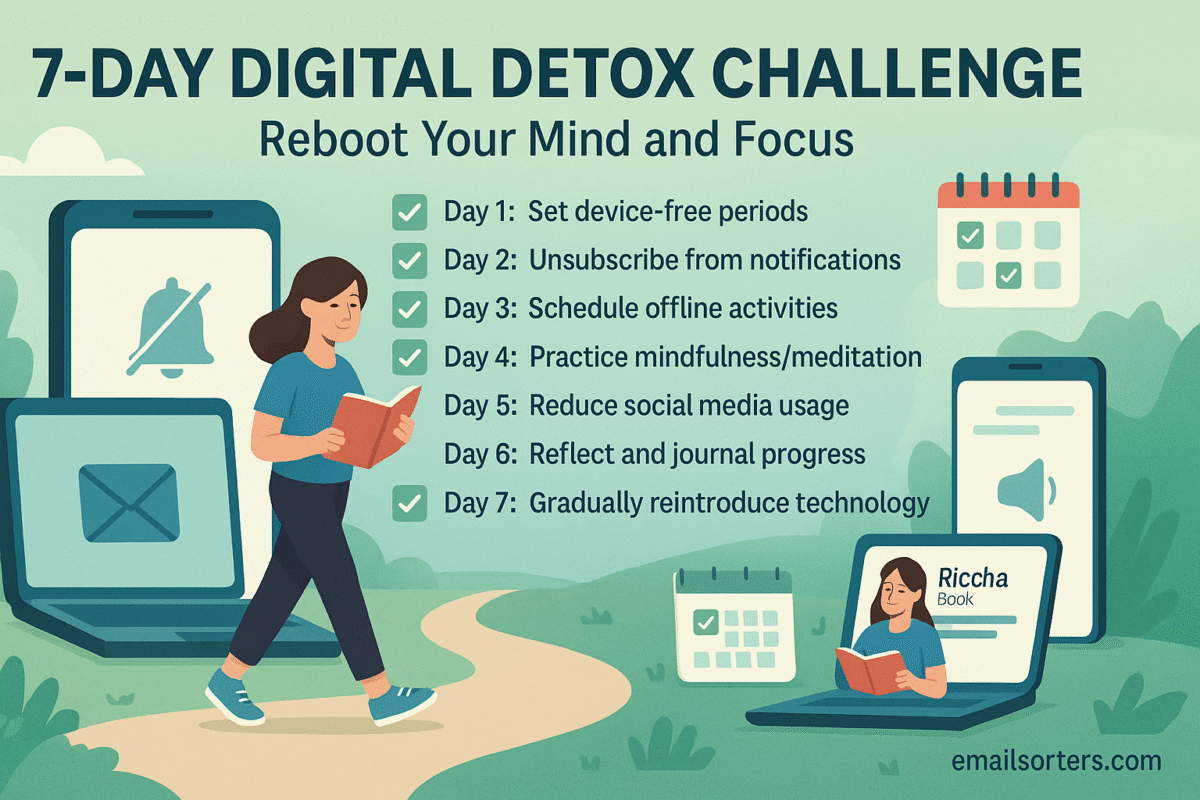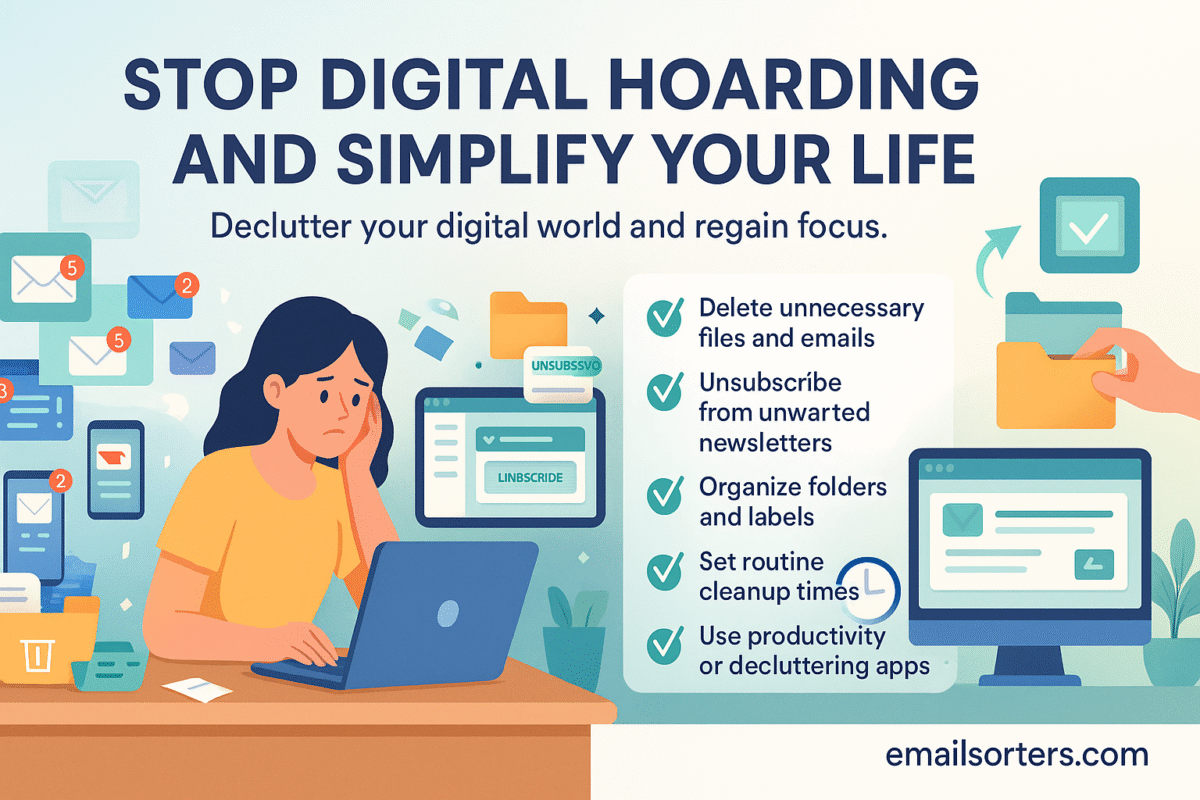Break the habit of refreshing your inbox, your feed, your notifications. It feels harmless: just one quick check. But before you know it, you’ve tapped refresh five times in ten minutes, hoping for something new that rarely shows up. Sound familiar?
The truth is, constant refreshing trains your brain to chase tiny hits of dopamine, leaving you distracted and restless. The good news? You can unlearn it. With the right strategies, you’ll spend less time waiting for updates and more time actually living.
Email is a powerful tool for communication, but for many, it’s also a major source of distraction. If you catch yourself refreshing your inbox every few minutes, you’re not alone. This habit often feels harmless, but it steals focus, raises stress, and eats up valuable time. The good news? You can break free from the cycle with a few intentional steps.
Let’s explore why inbox refreshing is so tempting, how it impacts your productivity, and the exact steps you can take to regain control.
Why We Constantly Check Our Inboxes
The Psychology Behind the Refreshing Habit
Email checking often becomes automatic. Without realizing it, you open your inbox when you hit a tough spot in a project or when you feel a moment of boredom. It’s the digital equivalent of pacing or fidgeting. The brain seeks novelty, and the inbox provides a quick hit of something new.
Dopamine Hits from New Messages
Every time a new email arrives, your brain releases dopamine, the “feel-good” chemical linked to reward and motivation. This chemical reinforcement creates a cycle: the more you check, the more you crave the possibility of something new. Even if most emails aren’t important, the chance of finding one that is keeps you hooked.
The Fear of Missing Out (FOMO) Factor
Another driver is fear of missing out. Many people worry that if they don’t check their inbox often, they’ll miss an urgent request, an opportunity, or important news. This fear pushes you to refresh again and again; even if most messages could easily wait.
The Downsides of Frequent Inbox Checking
How It Hurts Productivity
Refreshing your inbox every few minutes breaks your concentration. Each time you switch from a task to check email, your brain takes several minutes to refocus. Multiply this across a workday, and hours of potential productivity are lost.
The Stress and Anxiety Connection
Constant inbox checking keeps you in a state of low-level stress. You never fully relax, because you’re always “on alert” for new messages. Over time, this can increase anxiety levels, making it even harder to concentrate.
Impact on Work-Life Balance
For many, the habit doesn’t stop after work hours. Checking email at dinner, during family time, or late at night creates a sense of being “always on.” This blurs the line between personal and professional life, leading to burnout and strained relationships.
Step 1 – Acknowledge the Habit
Recognizing Triggers That Lead to Checking
The first step to breaking the cycle is awareness. Notice when you feel the urge to refresh. Is it when you’re stuck on a project? When you’re bored? When you hear a notification ping? Identifying patterns helps you take control.
Keeping a Log of When and Why You Refresh
For one week, track each time you check your inbox. Write down the time, the situation, and how you were feeling. Patterns will emerge; for example, maybe you check most during mid-afternoon slumps or right before bed.
Accepting That Change Takes Time
Breaking habits is a process. Don’t expect overnight results. Instead, set realistic expectations: you’ll gradually reduce how often you check, not stop instantly. Viewing progress as a series of small wins makes the goal more achievable.
Step 2 – Set Clear Email Boundaries
Scheduling Email-Check Windows
Instead of checking constantly, schedule specific times to look at your inbox. For example: once mid-morning, once after lunch, and once before wrapping up the workday. Knowing you’ll have dedicated windows helps reduce the urge to “just check” in between.
Deciding When Not to Check Emails
Equally important is setting “no-email zones.” Common examples include:
- During meals
- First hour after waking
- Last hour before bed
- While working on deep-focus tasks
These zones protect your energy and focus.
Communicating Boundaries with Colleagues
If your workplace expects fast responses, let people know your new approach. For example, set an auto-reply: “I check emails at 10 a.m., 1 p.m., and 4 p.m. If urgent, please call.” This sets clear expectations and reduces pressure.
Step 3 – Turn Off Push Notifications
Why Notifications Feed the Checking Habit
Push notifications are one of the biggest drivers of inbox refreshing. Each alert triggers an instant reaction: “What if this is important?” Even if you ignore it, the distraction breaks your focus.
Customizing Alerts for Only Urgent Messages
Instead of disabling all notifications, adjust settings so only the most important ones come through. For instance, allow alerts from your manager or top client but silence newsletters, promotions, and group threads.
Training Your Brain to Expect Fewer Interruptions
The fewer notifications you receive, the less your brain expects them. Over time, you’ll feel less compelled to check your inbox “just in case.” This builds a healthier relationship with email.
Step 4 – Use Email Management Tools
Filters and Labels for Organized Inboxes
A cluttered inbox fuels the urge to refresh, since you’re always hoping to catch up. Filters and labels can sort incoming emails automatically; important ones to your main inbox, newsletters to a “Read Later” folder, and promotions to a separate tab. When your inbox feels organized, the pressure to keep checking drops.
Auto-Replies to Reduce Pressure
Sometimes the urge to refresh comes from feeling like you must respond instantly. Setting up a polite auto-reply can help. For example:
“Thanks for your message. I check emails at scheduled times each day and will get back to you shortly.”
This reassures senders while giving you breathing space to stick to your schedule.
Tools That Batch Deliver Emails
Some email platforms allow you to receive messages in batches at set times instead of instantly. This feature reduces interruptions and trains your brain to expect fewer emails. Instead of dozens of pings throughout the day, you’ll only see new messages during your chosen windows.
Step 5 – Replace the Habit with Productive Alternatives
Short Activities for Idle Moments
Many people refresh their inbox simply because they don’t know what else to do in a spare minute. Replace that reflex with quick, meaningful activities:
- Jotting down a to-do list
- Reading a page of a book
- Stretching at your desk
- Doing a 2-minute breathing exercise
These alternatives satisfy the need for a quick break without feeding the inbox-checking cycle.
Mindfulness Instead of Mindless Refreshing
When you feel the urge to refresh, pause and take three deep breaths. Notice the urge without acting on it. Mindfulness builds awareness and makes it easier to choose a different response. Over time, this reduces the automatic pull toward your inbox.
Building a “No-Email” Morning Routine
Start your day without diving into email. Instead, focus on a high-priority task, a workout, or a short reading session. A no-email morning routine protects your mental energy and prevents your day from being shaped by other people’s demands.
Step 6 – Create an Environment That Supports Focus
Keeping the Email Tab Closed
If your inbox is always open, you’ll refresh it out of habit. Keep the tab closed and log in only during scheduled email windows. Out of sight really does mean out of mind.
Designating Email-Free Work Zones
Choose places where you don’t allow email checks; for example, your kitchen table, your reading nook, or your bedroom. These zones remind you that not every space in your life needs to be connected to work.
Using Focus Timers to Stay Engaged
Timers like the Pomodoro technique help you stay engaged with tasks. Set a 25-minute work timer, followed by a 5-minute break. Knowing you’ll have a break soon makes it easier to resist “just a quick check.”
Step 7 – Track Progress and Celebrate Small Wins
Measuring Improvement in Focus and Time Saved
Keep track of how many times you check your inbox daily. If you normally check 30 times a day and reduce it to 15, that’s a big win. Use this data to see how much time you’ve reclaimed each week.
Rewarding Yourself for Meeting Email Goals
Positive reinforcement makes new habits stick. When you meet your email goals for a week, reward yourself with something small but meaningful; like a favorite snack, a movie night, or time for a hobby.
Adjusting Strategies When Needed
If you notice the habit creeping back, adjust your approach. Maybe you need stricter filters, a different morning routine, or a new accountability system. Flexibility ensures long-term success.
What to Do If You Relapse
Normalizing Setbacks Without Guilt
Everyone slips up. Maybe you had a stressful day and checked your inbox more than planned. Don’t treat it as failure; it’s just part of the process. The goal is progress, not perfection.
Identifying the Cause of the Slip
Ask yourself: What triggered the relapse? Was it boredom, stress, or waiting on an important reply? Understanding the reason helps you prepare for similar situations in the future.
Resetting Quickly to Stay on Track
Don’t wait for “tomorrow” to restart. Take one immediate action; like closing your inbox, silencing notifications, or setting a focus timer. A quick reset prevents a minor slip from turning into a full return to old habits.
The Benefits of Breaking the Inbox Refresh Cycle
More Time for Deep Work
When you stop refreshing your inbox constantly, you gain blocks of uninterrupted time. This allows you to enter deep focus, where your brain works at its best. Projects that once felt overwhelming become manageable because you can finally give them your full attention. Many people find they finish tasks in half the time once they reduce inbox checking.
Reduced Stress and Better Mood
Constant checking keeps your nervous system in a state of alert. By cutting back, you reduce that background stress. You’ll feel calmer, more present, and less reactive. With fewer interruptions, you’ll also notice improvements in your mood, as your day is no longer dictated by every new email.
Stronger Focus Outside of Work
Breaking the habit doesn’t just benefit your work life; it improves personal time too. You’ll find it easier to enjoy meals, conversations, and hobbies without the nagging urge to check your inbox. This shift creates healthier boundaries between work and personal life.
Real-Life Success Stories
Students Who Broke Free from Inbox Checking
A graduate student struggling with thesis writing realized they were checking emails every 10 minutes. After scheduling two daily email windows and using a site blocker during study time, they regained hours each day. The result: better focus, less stress, and a completed thesis on time.
Professionals Who Boosted Work Efficiency
One project manager reported cutting email checks from 40 times a day to just 4. They used filters to organize messages and set up an auto-reply explaining their new system. Within weeks, they noticed better productivity and calmer workdays, without missing anything urgent.
Parents Who Regained Family Time
A parent noticed they were refreshing their inbox even during playtime with their kids. They set a strict rule: no emails after 6 p.m. The change led to more present family evenings and improved sleep, since they weren’t checking work emails right before bed.
Creating a Personalized Focus Plan
Setting Measurable Goals
General goals like “I’ll check less” don’t work well. Instead, create specific targets:
- Check email 3 times per day (morning, afternoon, evening)
- No inbox checks after 8 p.m.
- Reduce total daily checks by 20% each week
These measurable goals give you a clear way to track progress.
Writing a Daily Routine
Structure helps prevent backsliding. A sample routine could be:
- Morning: Focus on your most important task before checking email
- Midday: 15 minutes of email checking
- Afternoon: One more email check before ending work
- Evening: No emails; time for rest, hobbies, and family
When the routine becomes automatic, the urge to refresh weakens.
Reviewing Progress Regularly
Set aside 10 minutes at the end of each week to review how often you checked your inbox. If the number is going down, celebrate. If it’s going up, adjust your strategies. Regular reviews keep you accountable and motivated.
Long-Term Maintenance Strategies
Monthly Check-Ins
Habits can sneak back if you don’t monitor them. Once a month, review your email-checking frequency and reset your boundaries if needed. Think of it as a maintenance appointment for your productivity.
Adjusting Goals When Life Changes
Life events; like a job change or a busy season; may require temporary adjustments. Instead of abandoning your progress, adapt your plan. For example, allow one extra email window during busy weeks, then return to your normal schedule afterward.
Keeping Alternatives Ready
To stop boredom-triggered refreshing, always have alternatives at hand:
- A notebook for quick ideas
- A short article or book chapter
- A list of 5-minute offline tasks (watering plants, tidying your desk)
- Quick stretches or a breathing exercise
These options help you resist the urge to check your inbox out of habit.
Conclusion
Refreshing your inbox may feel harmless, but it quietly steals time, focus, and peace of mind. By following these seven steps; acknowledging the habit, setting boundaries, silencing notifications, using management tools, replacing the habit, creating a supportive environment, and tracking progress; you can break the cycle for good.
The result? More productive days, calmer evenings, and a healthier balance between work and personal life. Progress won’t be instant, but each small step brings you closer to lasting change.




